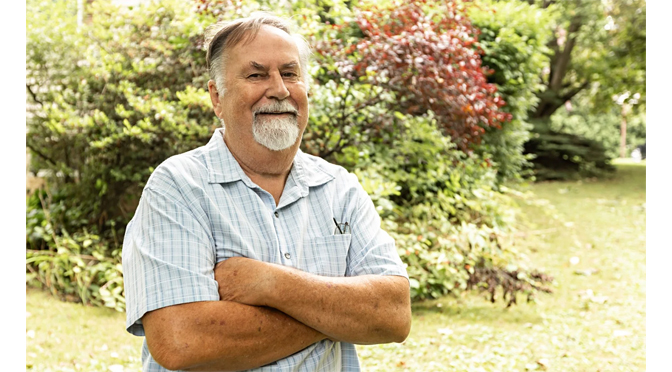|
|
New technology helps smooth the way back to a world with sound
LEHIGH VALLEY, Pa. (Aug. 16, 2024) — Ronald Van Rossum, 74, enjoys walking his dog. He can tell when Lager is ready for his walk because he can hear his nails tapping across the hardwood floor toward the door. For a long time, he was unable to hear that and other sounds, including people speaking to him on the phone.
“Hearing in my left ear started going bad two years ago,” says Van Rossum, a Vietnam veteran from East Greenville, Pa., whose job at a printing company meant working with loud offset printers for years after he left the service. “I wore hearing aids, and they helped for a while until this massive ringing started.”
Van Rossum consulted with Ravi Samy, MD, professor and Chief of Otolaryngology-Head and Neck Surgery at Lehigh Valley Institute for Surgical Excellence. Dr. Samy suggested a cochlear implant and explained how it would help him hear. “Mr. Van Rossum was a good candidate because he had lost all hearing in his left ear, and hearing aids were not helping him anymore,” he says.
Dr. Samy also believed Van Rossum would do well having the cochlear implant inserted using a new robotic-assisted system called iotaSOFT. Lehigh Valley Health Network (LVHN) is one of the first centers in the country using the thumb-sized system to guide cochlear implant procedures. “After talking with Dr. Samy, I really wanted the procedure,” says Van Rossum, who was the first iotaSOFT patient to be implanted in Pennsylvania. “I wasn’t anxious at all. I couldn’t wait to get it.”
An improvement in cochlear implants
According to Dr. Samy, cochlear implants are no longer just for those with severe hearing loss. The small devices comprise the implant, which is surgically placed underneath the skin, and an audio processor that sits outside, behind the ear. One component of the internal implant is the electrode array, a long skinny part that extends into the cochlea or inner ear. It contains electrodes that stimulate the inner ear like the cochlea do, sending sound signals to the brain.
The implants replace the damaged sensory hair cells inside the cochlea. Damaged or missing sensory hair cells do not regenerate, so this kind of hearing loss will not get better without treatment. While cochlear implants provide an improved quality of sound over that of hearing aids, they present challenges related to insertion, since even the best of surgical hands have a tremor.
“The goal is to insert the array into the cochlea with as little trauma as possible. The membranes and structures are so delicate they can tear, like wet tissue paper,” says Dr. Samy. He partnered with iotaMotion Inc., developers of the iotaSOFT Insertion System, to bring his patients this alternative. He remains committed to working with iotaMotion on the use of the system and future advancements of the technology. The system slows the process down, reducing the force and smoothing the insertion, so there is less disturbance to these sensitive areas.
“We do the best we can but we’re human,” he says. “This system is truly a game changer for many patients.”
The birds are singing again
Van Rossum’s life-changing moments started when his wife picked him up after the cochlear implant was activated by the audiologist. He noticed a sound he didn’t recognize and then realized it was the car’s turn signals. The amazement continued the next day at home. “I was sitting outside and could hear the birds singing. They sounded so loud!”
After a cochlear implant, there is still work to do to produce good results. Van Rossum is now undergoing mapping – fine-tuning the implant for better listening outcomes – with audiologist Alicia Stanley, AuD. He is also working with speech-language pathologist Lindsay Reuter. “Many people think that once you have the device activated, you can understand better right away,” Stanley says. “That would be like running a marathon the day after you get a knee replacement.”
She explains that, with normal hearing, we can naturally filter out background noise and focus on what we are listening to. After an implant, it’s necessary to retrain the brain to do that. “Ronald is a good example of a patient who is willing to put in the work, which can mean hours of aural rehab and listening therapies,” Stanley says. “His family is seeing the results, and we’re seeing the improvement.”
Van Rossum classifies himself as an ideal patient. “I can’t hear everything perfectly but every day it’s getting better,” he says. “I’m so pleased; I have zero complaints.” He acknowledges that his surgeon and the entire team made it a “truly amazing experience.”
“When I was in recovery, Dr. Samy came into the room, sat on a chair, and just chatted with me about all kinds of things,” Van Rossum says. “He is an incredible surgeon and an incredible human being. I told Dr. Samy he was a gift from God.”
About Jefferson
Nationally ranked, Jefferson, which is principally located in the greater Philadelphia region, Lehigh Valley and Northeastern Pennsylvania and southern New Jersey, is reimagining health care and higher education to create unparalleled value. Jefferson is more than 65,000 people strong, dedicated to providing the highest-quality, compassionate clinical care for patients; making our communities healthier and stronger; preparing tomorrow’s professional leaders for 21st-century careers; and creating new knowledge through basic/programmatic, clinical and applied research. Thomas Jefferson University, home of Sidney Kimmel Medical College, Jefferson College of Nursing, and the Kanbar College of Design, Engineering and Commerce, dates back to 1824 and today comprises 10 colleges and three schools offering 200+ undergraduate and graduate programs to more than 8,300 students. Jefferson Health, nationally ranked as one of the top 15 not-for-profit health care systems in the country and the largest provider in the Philadelphia and Lehigh Valley areas, serves patients through millions of encounters each year at 32 hospitals and more than 700 outpatient and urgent care locations throughout the region. Jefferson Health Plans is a not-for-profit managed health care organization providing a broad range of health coverage options in Pennsylvania and New Jersey for more than 35 years.
Information provided to TVL by:
Brian Downs







